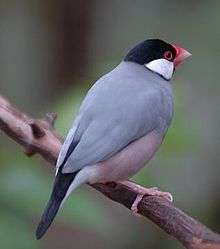Java sparrow
| Java sparrow | |
|---|---|
 | |
| Scientific classification | |
| Kingdom: | Animalia |
| Phylum: | Chordata |
| Class: | Aves |
| Order: | Passeriformes |
| Family: | Estrildidae |
| Genus: | Lonchura |
| Species: | L. oryzivora |
| Binomial name | |
| Lonchura oryzivora (Linnaeus, 1758) | |
| Synonyms | |
|
Padda oryzivora | |
The Java sparrow (Lonchura oryzivora), also known as Java finch, Java rice sparrow or Java rice bird, is a small passerine bird.[2] This estrildid finch is a resident breeding bird in Java, Bali and Bawean in Indonesia. It is a popular cage bird, and has been introduced in a large number of other countries. Some taxonomists place this and the Timor sparrow in their own genus Padda.
Description
The Java sparrow is about 15–17 cm in length from the beak to its tip of tail feathers. The adult is unmistakable, with its grey upperparts and breast, pink belly, white-cheeked black head, red eye-ring, pink feet and thick red bill.
Both sexes are similar. Immature birds have brown upperparts and pale brown underparts, and a plain head. Very young birds have a black beak with a pink base.
The call is a chip, and the song is a rapid series of call notes chipchipchipchipchipchip.
Molecular phylogeny indicates that this species may have originated in India and dispersed to Africa and Pacific Ocean habitats from there.[3]
Habitat
The Java sparrow is a very gregarious bird which feeds mainly on grain and other seeds. It frequents open grassland and cultivation, and was formerly a pest in rice fields, hence its scientific name. The nest is constructed in a tree or building, and up to eight eggs are laid.
Threats
The Java sparrow is considered to be a serious agricultural pest of rice. Due to ongoing habitat loss and hunting in some areas, the Java sparrow is now uncommon in its native range. It is evaluated as vulnerable on the IUCN Red List of Threatened Species and is listed on Appendix II of CITES.
Introductions


The Java sparrow was introduced in the Indian subcontinent,[4] but it failed to become a successful resident on the Indian mainland.[5] In the United States there are breeding populations on several of the Hawaiian Islands, especially Oahu.
In the Caribbean, the Java sparrow was introduced to Puerto Rico where it is fairly common near San Juan. It has also been sighted in Jamaica, but is not known to occur on any of the other islands.[6] It was also introduced to Christmas Island, off the coast of Western Australia.
Aviculture
The Java sparrow has been a popular cage bird in Asia for centuries, first in Ming Dynasty China and then in Japan from the 17th century, frequently appearing in Japanese paintings and prints. Meiji-era writer Natsume Sōseki wrote an essay about his pet Java sparrow. In the late 1960s and early 1970s the Java sparrow was one of the most popular cage birds in the United States until its import was banned. Today it remains illegal to possess in California because of a perceived threat to agriculture, although rice-dependent Asian countries like China, Taiwan and Japan have not regulated the bird.
In Asia the Java sparrow is most often raised almost from birth by human breeders and owners, and they become very tame and attached to humans. As such, they can be normally kept in relatively small cages, but let out for indoor exercise without their attempting to escape. In captivity, a variety of colourations have been bred, including white, silver/opal, fawn/isabel, pastel, cream and agate (which currently is rare within Europe captive specimens) along with the pied Java sparrow (called the sakura buncho in Japan).
References
- ↑ BirdLife International (2012). "Padda oryzivora". IUCN Red List of Threatened Species. Version 2013.2. International Union for Conservation of Nature. Retrieved 26 November 2013.
- ↑ Java Sparrow – Padda oryzivora (may change to Lonchura oryzivora). eFinch.com
- ↑ Arnaiz-Villena, A; Ruiz-del-Valle V; Gomez-Prieto P; Reguera R; Parga-Lozano C; Serrano-Vela I (2009). "Estrildinae Finches (Aves, Passeriformes) from Africa, South Asia and Australia: a Molecular Phylogeographic Study" (PDF). The Open Ornithology Journal. 2: 29–36. doi:10.2174/1874453200902010029.
- ↑ Hume, Allan Octavian. The Nests and Eggs of Indian Birds, Volume II. R. H. Porter, 1890, p.128.
- ↑ http://www.ceylonbirdclub.org/Appendix-II.pdf
- ↑ Herbert A. Raffaele; James Wiley; Orlando H. Garrido; Allan Keith; Janis I. Raffaele (23 April 2010). Birds of the West Indies. Princeton University Press. pp. 196–. ISBN 978-1-4008-3618-5.
- Finches and Sparrows by Clement, Harris and Davis, ISBN 0-7136-8017-2
External links
| Wikimedia Commons has media related to the Java sparrow. |
- Species factsheet - BirdLife International
- Java Colours - about the colours of the Java sparrow
- Feathers of the Java sparrow - Ornithos – Birdwatching in Europe
